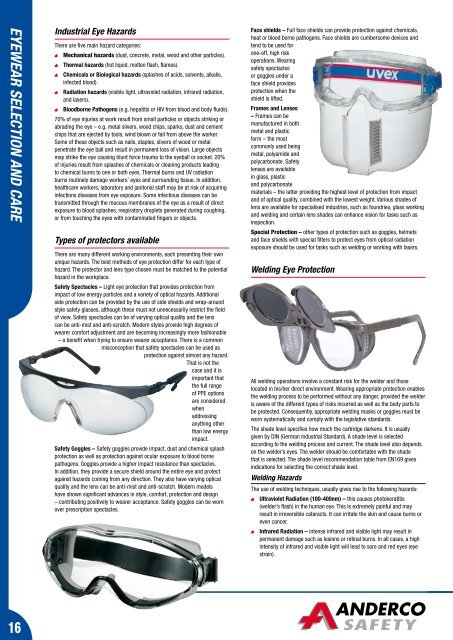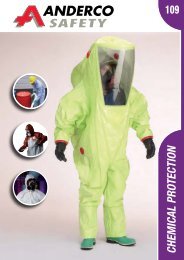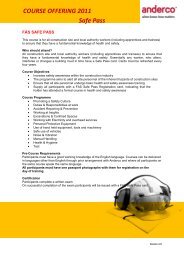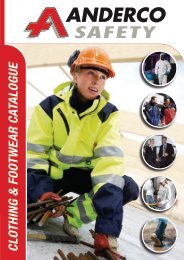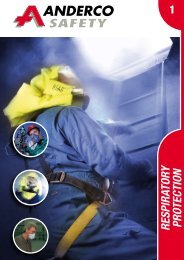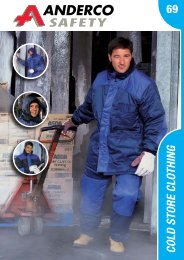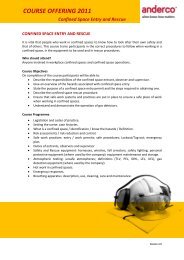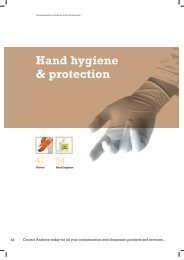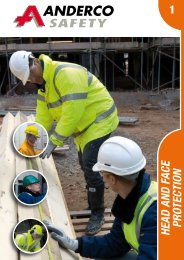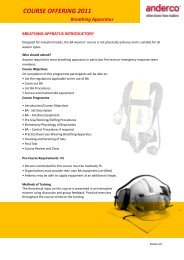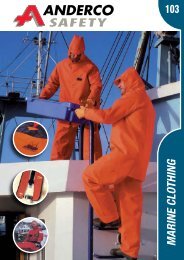eye protection - Anderco
eye protection - Anderco
eye protection - Anderco
- No tags were found...
Create successful ePaper yourself
Turn your PDF publications into a flip-book with our unique Google optimized e-Paper software.
EYEWEAR SELECTION AND CAREIndustrial Eye HazardsThere are five main hazard categories:Mechanical hazards (dust, concrete, metal, wood and other particles).Thermal hazards (hot liquid, molten flash, flames).Chemicals or Biological hazards (splashes of acids, solvents, alkalis,infected blood).Radiation hazards (visible light, ultraviolet radiation, infrared radiation,and lasers).Bloodborne Pathogens (e.g. hepatitis or HIV from blood and body fluids).70% of <strong>eye</strong> injuries at work result from small particles or objects striking orabrading the <strong>eye</strong> – e.g. metal slivers, wood chips, sparks, dust and cementchips that are ejected by tools, wind blown or fall from above the worker.Some of these objects such as nails, staples, slivers of wood or metalpenetrate the <strong>eye</strong> ball and result in permanent loss of vision. Large objectsmay strike the <strong>eye</strong> causing blunt force trauma to the <strong>eye</strong>ball or socket. 20%of injuries result from splashes of chemicals or cleaning products leadingto chemical burns to one or both <strong>eye</strong>s. Thermal burns and UV radiationburns routinely damage workers’ <strong>eye</strong>s and surrounding tissue. In addition,healthcare workers, laboratory and janitorial staff may be at risk of acquiringinfections diseases from <strong>eye</strong> exposure. Some infectious diseases can betransmitted through the mucous membranes of the <strong>eye</strong> as a result of directexposure to blood splashes, respiratory droplets generated during coughing,or from touching the <strong>eye</strong>s with contaminated fingers or objects.Types of protectors availableThere are many different working environments, each presenting their ownunique hazards. The best methods of <strong>eye</strong> <strong>protection</strong> differ for each type ofhazard. The protector and lens type chosen must be matched to the potentialhazard in the workplace.Safety Spectacles – Light <strong>eye</strong> <strong>protection</strong> that provides <strong>protection</strong> fromimpact of low energy particles and a variety of optical hazards. Additionalside <strong>protection</strong> can be provided by the use of side shields and wrap-aroundstyle safety glasses, although these must not unnecessarily restrict the fieldof view. Safety spectacles can be of varying optical quality and the lenscan be anti-mist and anti-scratch. Modern styles provide high degrees ofwearer comfort adjustment and are becoming increasingly more fashionable– a benefit when trying to ensure wearer acceptance. There is a commonmisconception that safety spectacles can be used as<strong>protection</strong> against almost any hazard.That is not thecase and it isimportant thatthe full rangeof PPE optionsare consideredwhenaddressinganything otherthan low energyimpact.Safety Goggles – Safety goggles provide impact, dust and chemical splash<strong>protection</strong> as well as <strong>protection</strong> against ocular exposure to blood bornepathogens. Goggles provide a higher impact resistance than spectacles.In addition, they provide a secure shield around the entire <strong>eye</strong> and protectagainst hazards coming from any direction. They also have varying opticalquality and the lens can be anti-mist and anti-scratch. Modern modelshave shown significant advances in style, comfort, <strong>protection</strong> and design– contributing positively to wearer acceptance. Safety goggles can be wornover prescription spectacles.Face shields – Full face shields can provide <strong>protection</strong> against chemicals,heat or blood borne pathogens. Face shields are cumbersome devices andtend to be used forone-off, high riskoperations. Wearingsafety spectaclesor goggles under aface shield provides<strong>protection</strong> when theshield is lifted.Frames and Lenses– Frames can bemanufactured in bothmetal and plasticform – the mostcommonly used beingmetal, polyamide andpolycarbonate. Safetylenses are availablein glass, plasticand polycarbonatematerials – the latter providing the highest level of <strong>protection</strong> from impactand of optical quality, combined with the lowest weight. Various shades oflens are available for specialised industries, such as foundries, glass workingand welding and certain lens shades can enhance vision for tasks such asinspection.Special Protection – other types of <strong>protection</strong> such as goggles, helmetsand face shields with special filters to protect <strong>eye</strong>s from optical radiationexposure should be used for tasks such as welding or working with lasers.Welding Eye ProtectionAll welding operations involve a constant risk for the welder and thoselocated in his/her direct environment. Wearing appropriate <strong>protection</strong> enablesthe welding process to be performed without any danger, provided the welderis aware of the different types of risks incurred as well as the body parts tobe protected. Consequently, appropriate welding masks or goggles must beworn systematically and comply with the legislative standards.The shade level specifies how much the cartridge darkens. It is usuallygiven by DIN (German Industrial Standard). A shade level is selectedaccording to the welding process and current. The shade level also dependson the welder’s <strong>eye</strong>s. The welder should be comfortable with the shadethat is selected. The shade level recommendation table from EN169 givesindications for selecting the correct shade level.Welding HazardsThe use of welding techniques, usually gives rise to the following hazards:Ultraviolet Radiation (100-400nm) – this causes photokeratitis(welder’s flash) in the human <strong>eye</strong>. This is extremely painful and mayresult in irreversible cataracts. It can irritate the skin and cause burns oreven cancer.Infrared Radiation – intense infrared and visible light may result inpermanent damage such as lesions or retinal burns. In all cases, a highintensity of infrared and visible light will lead to sore and red <strong>eye</strong>s (<strong>eye</strong>strain).16


